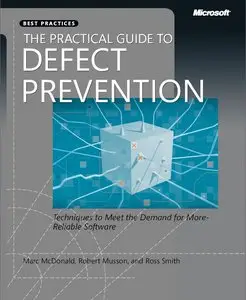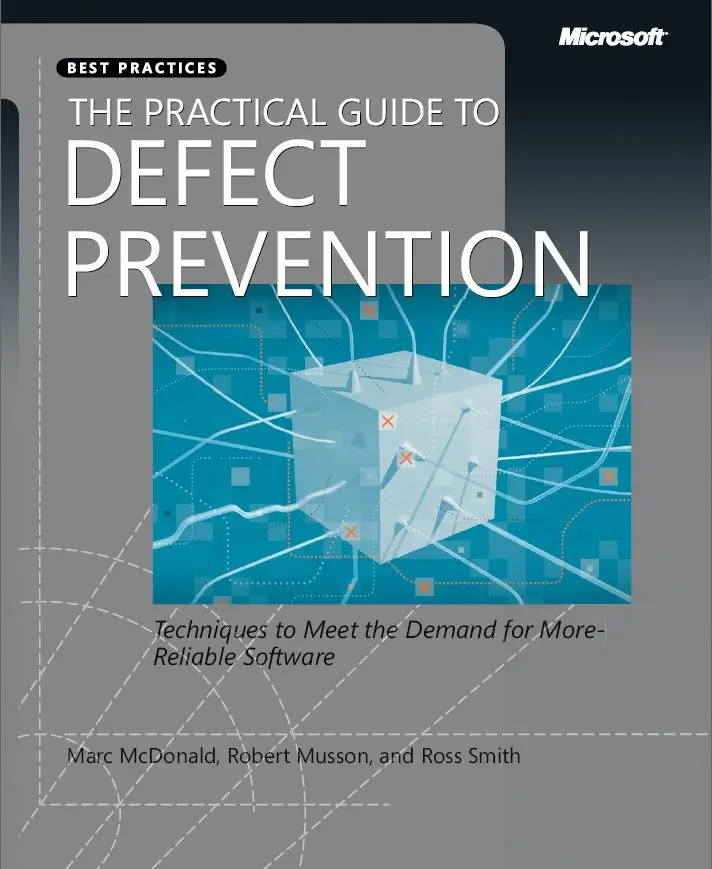The Practical Guide to Defect Prevention (Best Practices) By Marc McDonald, Robert Musson, Ross Smith
Publisher: Microsoft Press 2007-03-07 | 478 Pages | ISBN: 0735622531 | PDF | 3.3 MB
Publisher: Microsoft Press 2007-03-07 | 478 Pages | ISBN: 0735622531 | PDF | 3.3 MB
This practical, hands-on guide captures, categorizes, and builds a process of best practices to avoid creating defects during the development process—rather than fixing them after extensive analysis. While there are various proprietary and competing standards for reducing software defects, these methods suffer from issues surrounding timeliness, effectiveness, or cost. What’s more, many other books focus on fixing errors after they’ve been introduced. This guide, however, presents practical methods for reducing defect introduction through prevention and immediate detection and by moving the detection of defects closer to their introduction. Written by experts with over a century of software development experience among them, this book is not an idealized academic book. Instead, it distills many hard-won lessons into a single, workable lifecycle process that will help deliver better quality software.
Key Book Benefits:
• Distills best development practices upstream in the coding cycle by offering techniques and methods to help eliminate bad code before a bug is released
• Provides a full collection of tools and forms to enable immediate use of the techniques described
• Features coverage of, and integration with, allied methodologies for organizations that use Six Sigma, Agile, Burton, and other similar-quality tools
About the Authors:
The seven authors are members of the Defect Prevention Team at Microsoft.
Lead authors:
Marc McDonald's career spans the entire 30-year personal computer industry from its infancy with the MITS Altair to today. He was Microsoft's first salaried employee, and he designed the FAT file system for MS-DOS. He holds five software patents. He has worked as a principal research scientist and developer for several companies in between stints at Microsoft.
Robert Musson has more than 25 years of software experience as a development engineer and in various management positions. He spent 15 years at Teradyne, helping bring to market a variety of products for the telecommunications industry. While there, he helped deploy the Team Software ProcessSM (TSPSM) to the first industry site. He was vice president of business strategy at a small startup before becoming a member of the TSP Initiative at the Software Engineering Institute.
Ross Smith has been in the software industry for almost 20 years, developing and testing software on mainframe systems, handheld devices, Windows, and Microsoft Office. He holds five software patents.
Review:
Everyone knows it's cheaper and smarter to prevent software bugs upstream, rather than painfully finding and excising them during testing and QA. But not everyone knows how to do that. Read this book, and you will.
The authors have seen it all: One was Microsoft's first salaried employee; another has participated in SEI's leading-edge research on software quality. Here, they systematically cover today's best-practice approaches for earlier defect detection, analysis to identify and avoid future defects, and moving to "a culture of prevention."
The authors, relentlessly practical, know you can't do everything. So they help you pick the techniques that offer you the biggest bang. They offer tools to get you started. They even guide you on integrating defect prevention with existing methodologies (Six Sigma, Agile, Burton). They've taken on today's biggest (and most challenging) opportunity for improving software development – and come away victorious. Bill Camarda, from the November 2007 Barnes & Noble newsletter.





